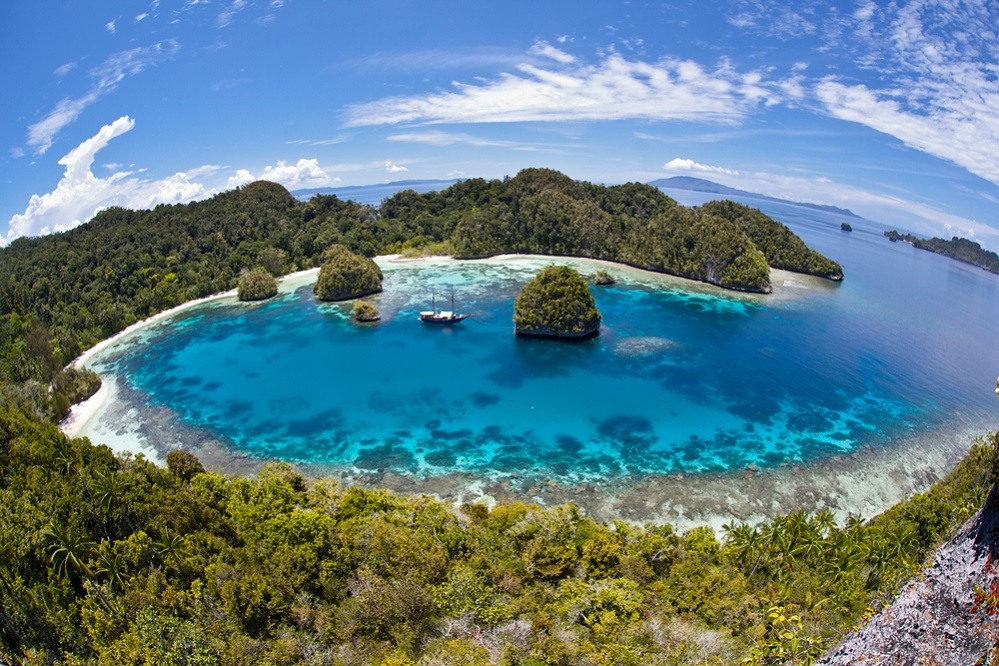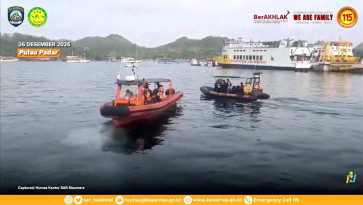Popular Reads
Top Results
Can't find what you're looking for?
View all search resultsPopular Reads
Top Results
Can't find what you're looking for?
View all search resultsSearch for birds of paradise in Indonesia, and you’ll find so much more
Long before COVID-19 sent us all indoors, I had dreamed of traveling by boat to West Papua and the Raja Ampat islands to discover the area’s pristine reefs, karst formations, and those bewitchingly colorful birds of paradise.
Change text size
Gift Premium Articles
to Anyone
I
n 1937, my great-grandmother, Constance Ripley, who was in her mid-60s at the time, took a weeks-long voyage by passenger ship, most likely changing vessels several times, across the globe. Her destination was, and still is, an incredibly remote place in the minds of most people: the far corner of an archipelago then known as the Dutch East Indies and now the Indonesian province of West Papua.
She eventually arrived by mail boat in the small port city of Sorong, where she would meet up with her adult son, an ornithologist collecting bird specimens and their skins for the Academy of Natural Sciences in Philadelphia. There were no hotels, so my great-uncle Dillon had arranged for her to stay with the local Dutch officer in charge of the region, in his family’s complex of thatched houses. While her son conducted his work in the jungle, my great-grandmother went on day trips with her hosts to visit neighboring islands, picnicking in empty coves and hiking to remote waterfalls.
I think of her adventures often while sheltering in place at my home north of Atlanta, where daily excursions to nearby parks help preserve sanity for me and my three newly homeschooled children (all under the age of 13). When a colorful bird darts through a jungle-like path, it makes me wonder what it must have been like for Constance Ripley to explore remote Indonesia in the 1930s.
My great-grandmother died about eight years before I was born; I first learned of her passionate appetite for adventure while reading my great-uncle Dillon’s memoir and the adventures that led him to become director of the Smithsonian Institution. Among its more interesting passages are accounts of the cannibalistic Karoon tribes, which Dillon understood was engaged in preserving the bodies of dismembered prisoners with lichen salve in order to feast on them more slowly.
In the last chapter of the book, Dillon and Constance take an industrial freighter back to the US with almost 100 live birds. During the two-month journey, they feed the birds a diet that adds up to 2,000 bananas, 150 melons, 800 pounds of assorted grains, and 200 pounds of fish. Somewhere off the coast of Sumatra, a Bornean crested fireback pheasant goes overboard. When they pull into Boston Harbor on July 14, 1938, my great-grandmother says: “I shouldn’t mind at all just turning around and sailing somewhere else all over again.”
A lifelong fantasy
I could have said the same thing myself. Long before COVID-19 sent us all indoors, I had dreamed of traveling by boat to West Papua and the Raja Ampat islands to discover the area’s pristine reefs, karst formations, and those bewitchingly colorful birds of paradise. Besides studying abroad in Indonesia in the 1990s and living there for two years in my 20s, I’ve spent decades chronically obsessing over the naturalists who made the country a second home. There were Lawrence and Lorne Blair, British brothers and cultural documentarians, and Alfred Russel Wallace, who conceived the theory of natural selection concurrently with Charles Darwin. Was it coincidence or hereditary—some sort of epigenetic phenomenon—that my wildest fantasy so closely echoed my adventurous forbears?
Currently, Indonesia, the world’s fourth-most-populous country, is enmeshed in a Covid-19 crisis with the highest number of cases in Southeast Asia. So while I daydream about following in Constance’s footsteps and seeing a bird of paradise in the wild, I am in no hurry. If she did it in her 60s, I can, too. And while I wouldn’t mind traveling by freighter, at a much slower, more sustainable pace than modern convention, I’d also be delighted to bring my family along (in a slightly more comfortable ride). It might be the best way, after all, to go as far off the beaten path as my forbears did almost 100 years ago.
Read also: 10 great reasons to visit West Papua
A true dream boat
I first learned about Kudanil Explorer, one of the world’s most comfortable and stylish expedition boats, from longtime Indonesiaphile Jason Friedman, who helps curate its itineraries and experiences. A former oil rig, the vessel now contains a state-of-the-art dive center and a fleet of kayaks, some with glass bottoms.
From November to January, it cruises West Papua and the Raja Ampat islands, offering its guests an unparalleled amount of space and privacy. Its eight spacious cabins blend mid-century modern Scandinavian design with such tribal Indonesian details as ikat bed throws and indigenous art. Each has floor-to-ceiling windows that open out to a private balcony. There’s also a spa suite with rattan walls, a library lounge, a modern screening room, and two restaurants, including one on a covered patio open to the sea breeze.
I don’t think my great-grandmother would have argued with this version of adventure-lite: one with perfect, flat white coffees, next level Indonesian-inspired cuisine, massages, and Wi-Fi.
Where we’ll sail
No trip on the Kudanil Explorer is the same. Depending on the mood of the guests, the captain can change the day’s plan spontaneously to add a trek to a waterfall or to locate an undiscovered beach. A journey that my friend recently took with the renowned hotel designer Bill Bensley, would serve as a template for my own, I hope. Theirs began in the wild outpost of the Kaimana province and ended in Sorong, West Papua’s major harbor city. (It was also my great-grandmother’s first port of call.) Kudanil Explorer is planning several such trips for 2021, in conjunction with nights in the stunning Bensley-designed resort Capella Ubud in Bali; even better, some expeditions include my hero Lawrence Blair, the documentarian, as an on-board guide.
If I could have my way, I’d add an additional brain to the roster: French ornithologist Christophe Thebaud. Kudanil has hired him in the past as a visiting expert, and guests can make special requests if they’re willing to pony up. “The thing about looking for birds of paradise is that they are extremely difficult to see,” Thebaud tells me over the phone. “But they are easy to hear. They occupy the soundscape of that corner of the world, which just happens to be one of the most extraordinary.” His ears would be my eyes, so to speak, as we seek out the magnificent birds that colored my relatives’ stories.
The best places to spot these kaleidoscopic creatures are in the jungles of West Papua and Papua New Guinea, as well the Raja Ampat island of Waigeo, where it still takes concerted effort to find fleeting flashes of color amid dense tangles of greenery. “The forest is more diverse than a coral reef, but it takes effort to see it,” Thebaud warns me. Behind binoculars, we’d await sightings of the red (or Wilson’s) bird of paradise, which bears large patches of brilliant red, blue, and yellow across its head and body. But my dream would be able to catch a Vogelkop superb bird of paradise—the iconic black species with a neon blue “smiley face”—in the middle of a mating dance, its wings spread completely around its body like a disc, to create that emoji-like illusion.
Among these missions in the thick brush, we’d rest our weary eyes with adventures of another kind. We’d dive with whale sharks outside Triton Bay, where palm trees line the sugary sand beaches like eyelashes; we’d picnic and sunbathe in empty coves, or take a motorized canoe up a crocodile-lined river; and we’d visit the tiny village of Lobo, where tribal populations gather and trade.
Sounds for sore ears
Speaking with Thebaud made me realize that even after crossing the globe to chase the birds of paradise, I wouldn’t be that disappointed if I failed to spot one. Wallace, the 19th century naturalist, wrote of the great paradox that, if “civilized man ever reach these distant lands” where such rarified species live, he would surely disturb nature just enough to “cause the disappearance, and finally the extinction, of these very beings.” Responsible, small-scale tourism aside, it may be that there are certain wonders we are not meant to see for ourselves, in order for them to continue thriving.
Listening to the staccato hooting of birds of paradise from the jungle canopy as I head upstream in a canoe, hornbills flying overhead, would be more than enough. Certainly, it would provide plenty of contrast from our current indoor stasis. After all, some of my great-grandmother’s favorite moments happened on a freighter ship during the journey home—not just when she spotted a moonbeam over phosphorescent waters, but in the simple acts of reading a book on the deck, enjoying the company of her son, and whiling away with a coterie of chatty parrots.
While booking a trip to Indonesia might not be immediately possible, supporting World Central Kitchen is. This organization, which is close to the writer’s heart and run by chef Jose Andres, has pledged to subsidize 1 million meals across the United States—all to be prepared at 400 independent restaurants that need help staying afloat during the crisis.







